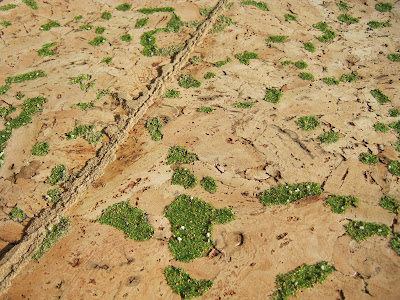Finally got some time to put together a post on the game's second outing last week in Edinburgh:
First up we are looking at the Thebans and other medizing Greeks who make up the right wing of the invading army. The hoplites are my Garrison figures, which I picked up really cheaply at Wappinshaw in Glasgow years ago. I have added extra figures to give me enough for ten units of 36 hoplites, although I still need to do quite a lot of work on these. I think they look really good en masse, and they are sufficiently different from the rest of my collection so that I can use them in opposition.
The second photo shows the Persian army's right centre, composed of Bactrians, Sakae and Indians.
Above you can see the Persian left centre, comprising the Sparabara in their myriad ranks, with skirmishers out fornt.
To finish the attackers' deployment, we have the army's left wing led by Mardonius in person. This comprises the better cavalry and the best of the infantry. My token Persian contribution is the unit of recently painted Immortals at the top right of the shot.
Turning around, we have the Spartans on their hill opposite Mardonius.
Next comes the Perioikoi and the Tegeans, held furthest back.
The shot above shows the central two commands of Corinthians and allied hoplites. They are not yet on the field, but I have found through experience that it is best to set them up in column at the point of arrival, rather than disturb a large game half way through by putting fresh troops on the table. Meanwhile, Thomas is quite happily trashing Mario or something...
Completing the Greek army, we have the Megarans, Plataeans and Athenians on the army's left opposite the Thebans. They are on the field proper, and are in a very bad mood.
Above, you can see the opening moves on the left of the Persian army. Most of the cavalry is sent forward to hold the Spartans for a while as Mardonius leads the guards toward the flank.
Above is a gratuitous long shot of the whole field at this point, taken from more or less the same place. On the left, you can see that the Greek centre still hasn't arrived.
Another shot of the whole field at the same moment, this time from the other wing. The Thebans are in the left foreground, and the athenians in front of them have angled one unit a bit to try to stop the lone group of enemy Thessalian horsemen coming around the flank.
Staying on this wing as the two lines of hoplites close.
The Greek centre has finally arrived and deployed into line.
Mardonius continues to ride around Spartan Hill...
...and keeps going.
A long view of most of the field at this time from the same position.
In the centre, the Bactrian light horse disperses into skirmish formation and attacks the Greek skirmishers. The central hoplite line is advancing now.
A real grudge match develops between the Thebans and the Athenians. Two lines of hoplites colliding is a noisy experience, apparently.
Meanwhile, the armies' centres line up in anticipation. Will the Sparabara in the foreground hold out against the formidable hoplites advancing upon them?
Facing Spartan Hill, the Immortals deploy their shield barrier. But where is Mardonius with the Guard Cavalry?
There he is!
Another full field view, same place and time.
In the centre, the hoplites move closer. They aren't taking enough arrow damage to satisfy the Persians and their subjects.
Another full table shot from the usual place as the Spartans and Perioikoi go into the opposition. On the left, you can see Mardonius beginning to angle in to attack the hoplites in the rear. Will he be too late?
A close shot of the crush from behind the Immortals. Mardonius can just be seen in the distance cresting the hill.
A view of the hoplite struggle from behind the Thebans. It is not going well for them.
The Megarans begin to break through as the Thebans start to run for it.
The melee is now general right along the line. The photo above shows the extreme left of the Persian army. My Immortals are doing really well; usually a newly painted unit routs at the first sign of trouble!
Mardonius drives in toward the rear of the Tegeans.
It looks as though he is too late to make a difference, though - the Thebans have been vanquished as a great expanse suddenly appears at the right of the Persian host.
In goes Mardonius, destroying the Tegeans and a unit of Corinthians. Some of the Perioikoi waver as well..
The Guard's moment of glory. But it is indeed too little too late. The Saparabara rout in their entirety and the Immortals start to give way. Greek combat ability makes for a major victory.


















.jpg)





















.jpg)







.jpeg)













.jpg)


























































































































